Key takeaways:
- Pair programming enhances learning through real-time feedback and collaboration, fostering a dynamic atmosphere for problem-solving.
- Key techniques include “Ping-Pong” pairing for engagement and “driver-navigator” roles to leverage different strengths in coding sessions.
- Effective communication, including verbalizing thoughts and adapting styles, is crucial for successful collaboration and overcoming challenges.
- Pair programming fosters personal growth by exposing individuals to diverse perspectives and boosting confidence through support and encouragement.
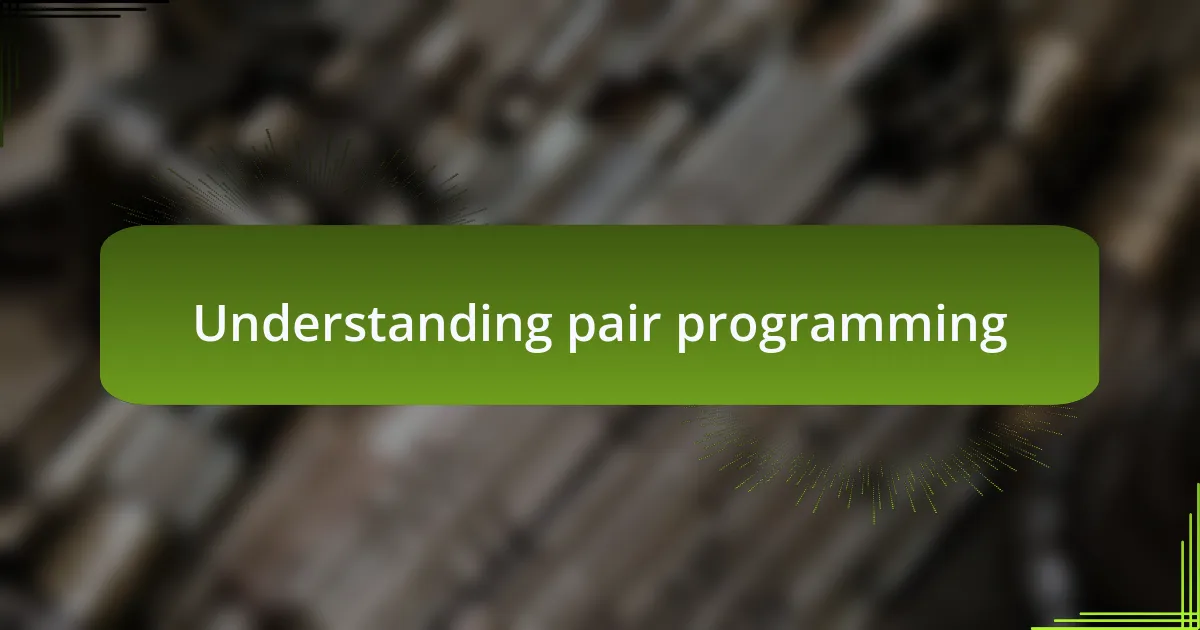
Understanding pair programming
Pair programming is a collaborative coding practice where two programmers work together at one workstation. I remember my first experience with this method vividly; I was paired with a seasoned developer who guided me through the maze of a complex codebase. I realized how much I learned just by asking questions and observing his approaches to problem-solving. Have you ever felt stuck on a problem and wished someone could just walk you through it? That’s precisely the transformative power of pair programming.
In essence, one person drives the code, while the other acts as an observer and collaborator. This setup creates a dynamic environment where ideas flow freely. I once found myself in a situation where my partner keyed in a section of code, and I suggested a slight modification that completely changed the logic. It was a small moment, but the excitement we felt when it worked seamlessly was unforgettable. Those “aha” moments are not just rewarding; they also solidify your understanding and make learning feel exhilarating.
Furthermore, pair programming fosters a supportive atmosphere that encourages communication and trust. I have found that when I pair with someone, it feels less like a solitary task and more like a shared mission. It’s fascinating how quickly a connection develops, and suddenly, you aren’t just two individuals working on a project; you become a team tackling challenges together. Can you recall a time when teamwork sparked your creativity? Pair programming encapsulates that joy of collaboration beautifully.
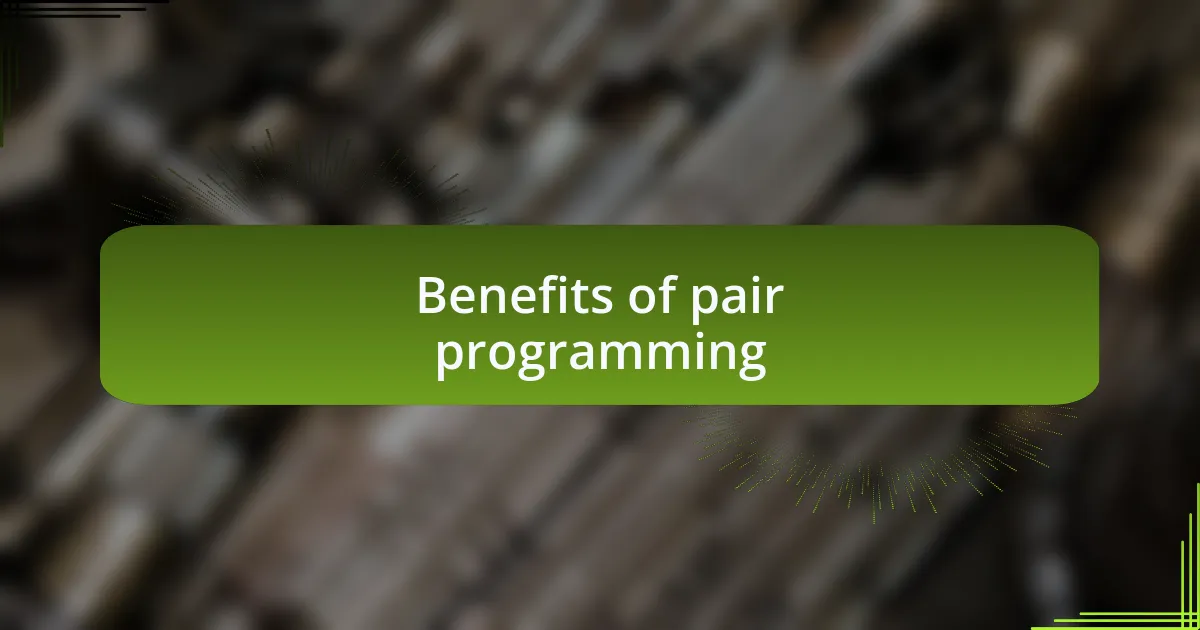
Benefits of pair programming
One major benefit of pair programming is the immediate feedback loop it creates. I remember a project where I struggled with a particularly tricky algorithm. My partner not only spotted my logical flaw right away but also explained why it was an issue. It felt refreshing to have that real-time critique, which not only sped up the debugging process but also deepened my understanding of the material. Have you ever wished you could get instant clarity on your work?
Another advantage I’ve noticed is the way pair programming accelerates skill development. During one session, I found myself pairing with a colleague who was an expert in a programming language I was less familiar with. As we worked through the code together, I soaked up techniques and shortcuts I had never encountered before. Each moment was an opportunity to learn, and it really transformed my coding abilities. Don’t you think learning from someone else’s expertise can be incredibly empowering?
Finally, pair programming enhances team cohesion and morale. I’ve had countless instances where working closely with others helped me build friendships and trust within the team. One time, as we tackled an intense sprint, the energy of collaborating in real-time made the pressure feel lighter. It’s as if shared goals and challenges forged bonds that extended beyond the project. How often do we find camaraderie in the rush of deadlines? Pair programming captures that spirit perfectly.
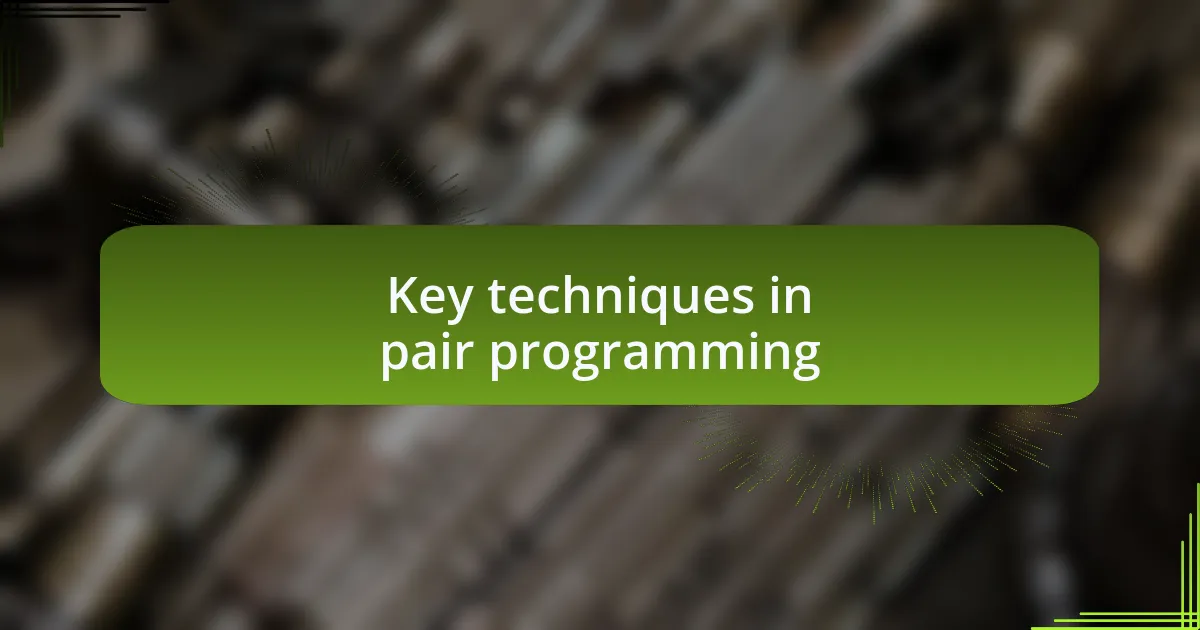
Key techniques in pair programming
There’s a technique in pair programming called “Ping-Pong,” where the roles of driver and navigator swap frequently. I still recall a session with a colleague where we embraced this method. It kept us both engaged and allowed us to immediately apply feedback, ensuring both of us remained equally invested in solving the problem. Have you ever found that switching roles not only keeps the energy up but also builds a fuller understanding of the code?
Another technique that has significantly benefited me is “driver-navigator pairing.” In this approach, the driver writes the code while the navigator reviews it and offers guidance. I once paired with a team member who excelled at thinking through problems conceptually. As a driver, I could focus on coding, while my partner’s insights helped refine my approach. It’s wonderful how this dynamic creates a dual perspective that enhances problem-solving. Can you think of a time when collaborating in such a way opened your eyes to new possibilities?
Lastly, using “real-time documentation” has become essential during our sessions. I’ve often found myself jotting down insights, decisions, and code snippets as we worked through problems together. It’s amazing how capturing immediate thoughts can simplify the later stages of a project. On one occasion, those notes helped clarify a complex feature that would have otherwise led to misunderstandings. How often do you find that reflecting on ongoing discussions paves the way for smoother collaboration?
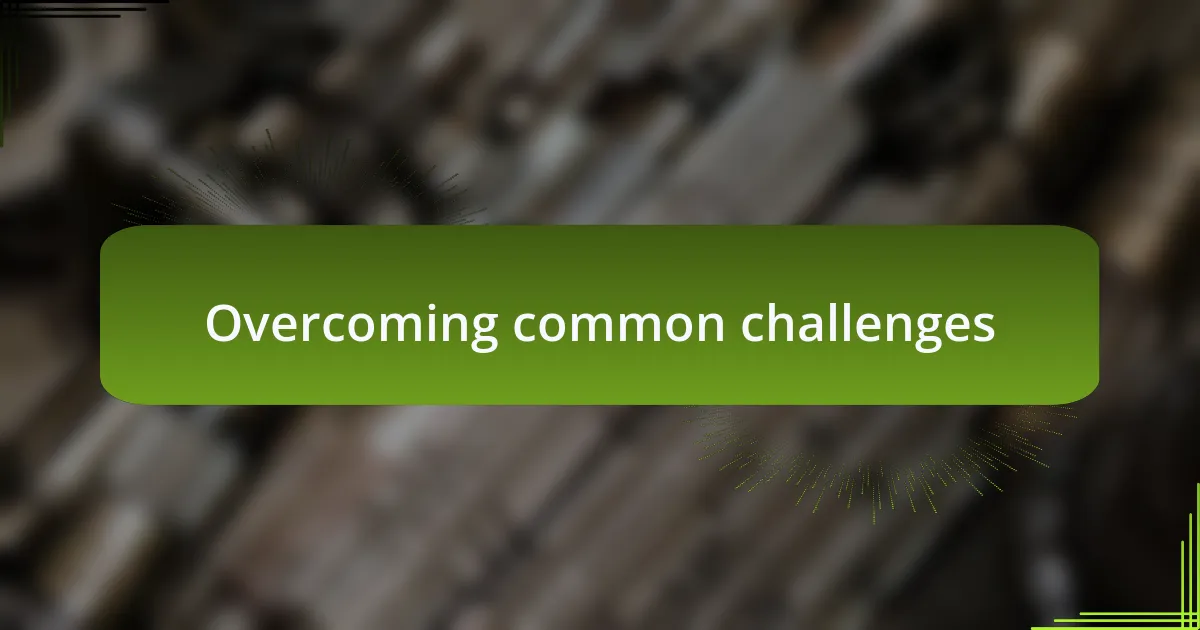
Overcoming common challenges
When diving into pair programming, I often encounter challenges like miscommunication or differing coding styles. I remember one session where my partner and I struggled to align our approaches. It was only when we paused to discuss our thought processes that we discovered how beneficial it is to understand each other’s coding philosophies. Have you ever struggled to sync up with a teammate and realized that a simple conversation could bridge the gap?
Another common hurdle is balancing the pace of work between partners. In one memorable instance, I was racing ahead while my partner was still processing the previous task. This mismatch led to frustration on both sides. It became clear that slowing down to check in regularly not only eased the tension but also improved our workflow. Don’t you think there’s great value in maintaining a steady rhythm that respects both viewpoints?
Finally, fostering a comfortable atmosphere can be tricky, especially if one partner feels more experienced. During a pair session, I noticed my less experienced partner hesitated to voice her ideas. I chose to create an open space by asking her opinion on various decisions. This encouraged her to contribute more actively, and soon, our dynamic flourished. Have you found that creating a supportive environment opens the door to creativity and collaboration?
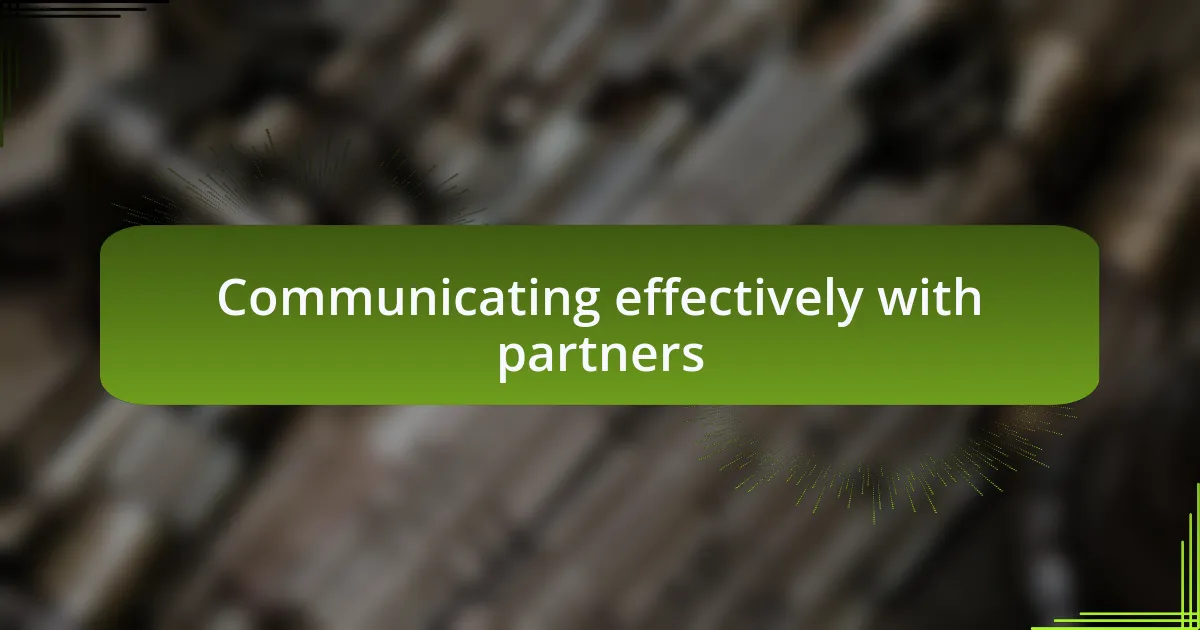
Communicating effectively with partners
Communicating effectively with partners
Having clear communication with my programming partner has made all the difference in our sessions. I recall one day when we were tackling a particularly complex feature; I noticed my partner seemed overwhelmed. By simply asking, “What do you think would help us tackle this together?” we opened a dialogue that not only clarified our goals but also eased the pressure we both felt. Isn’t it fascinating how a simple question can transform the entire atmosphere of collaboration?
One thing I’ve learned is the importance of verbalizing thought processes. During a recent project, I found myself explaining my decision-making as I coded. This practice turned out to be enlightening—not just for my partner, who gained insights into my approach, but also for me, as articulating my thoughts helped refine my own understanding. Have you experienced moments where verbalizing your thoughts not only clarifies your own mind but also enlightens others?
Another key element is adapting to each partner’s communication style. While one colleague prefers direct feedback, another achieves more through gentle suggestions. I remember a time when I misread my partner’s hints as hesitations, leading to unnecessary confusion. Transforming how we responded to each other made our collaboration smoother and more enjoyable. Doesn’t it make sense to tailor our communication to fit individual styles, building a stronger connection in the process?
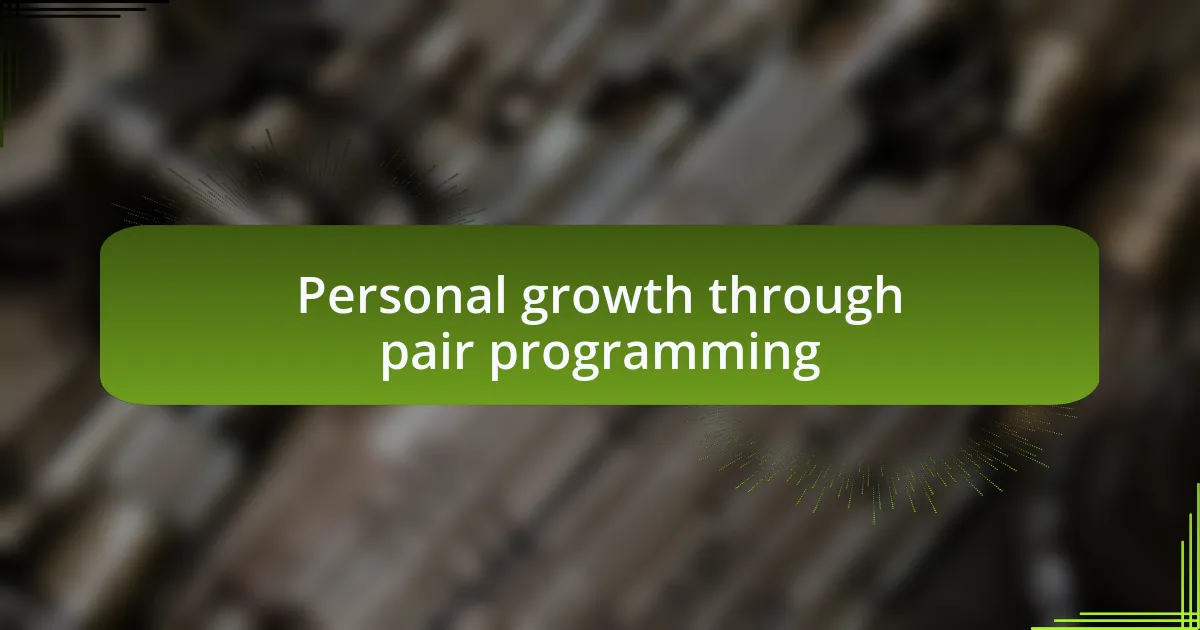
Personal growth through pair programming
Pair programming has been a significant catalyst for my personal growth, exposing me to diverse perspectives and strategies. I recall a session where I worked alongside a partner who had a very analytical mindset, much different from my own. Watching how she dissected problems with precision taught me to slow down and consider various facets before jumping to conclusions. Doesn’t it amaze you how another person’s approach can reshape your own thinking?
This experience also pushed me out of my comfort zone. On more than one occasion, I had to navigate unfamiliar coding languages or frameworks that I hadn’t previously encountered. Initially, I felt intimidated, but with my partner’s encouragement, I embraced the challenge. I discovered that stepping into uncharted territory with a trusted teammate not only enhances skills but also builds confidence. Have you ever taken a leap like that, only to find it enriches both your knowledge and self-assurance?
Moreover, the emotional support I found during these sessions has been invaluable. Facing coding hurdles can be discouraging, but when I was battling self-doubt, my partner would often remind me of past successes. Those moments of affirmation were pivotal; they reinforced that growth happens even in the midst of obstacles. Don’t you think having someone believe in you can be the key to unlocking your full potential?